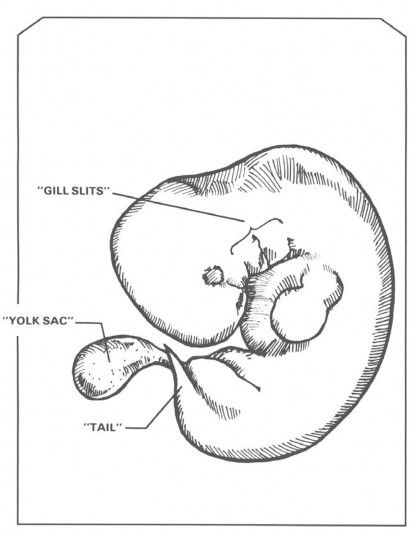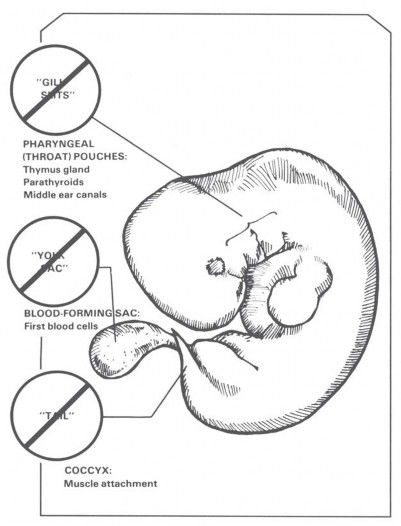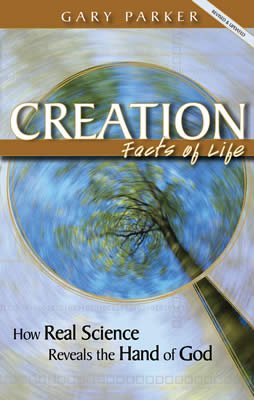
1.5 Embryonic Development
Evidence of Creation?
Some see the birth of a child as the most personal expression of God’s creativity, but evolutionists say, “Look, if you’re talking about creation, then surely the Creator must not be very good at it, or else there wouldn’t be all those mistakes in human embryonic development.”
Figure 7 shows an early stage in human development. Consider it your first “baby picture.” You start off as a little round ball of unformed substance. Then gradually arms, legs, eyes, and all your other parts appear. At one month, you’re not quite as charming as you’re going to be, and here’s where the evolutionist says, “There’s no evidence of creation in the human embryo. Otherwise, why would a human being have a yolk sac like a chicken, a tail like a monkey, and gill slits like a fish? An intelligent Creator should have known that human beings don’t need those things.”
Well, there they are, “gill slits, yolk sac, and a tail.” Why are they there? What’s a creationist going to say? The evolutionist believes these structures are there only as useless leftovers or “vestiges” of our evolutionary ancestry, reminders of the times when our ancestors were only fish, reptiles, and apes.
The concept of vestigial organs even resulted in cases of “evolutionary medical malpractice.” Young children once had their healthy (and helpful, disease-fighting) tonsils removed because of the widespread belief that they were only useless vestiges. That idea actually slowed down scientific research for many years. If you believe something is a useless, non-functional leftover of evolution, then you don’t bother to find out what it does. Fortunately, other scientists didn’t take that view. Sure enough, studies have shown that essentially all 180 organs once listed as evolutionary vestiges have significant functions in human beings.
Take the yolk sac, for instance. In chickens, the yolk contains much of the food that the chick depends on for growth. But we, on the other hand, grow attached to our mothers, and they nourish us. Does that mean the yolk sac can be cut off from the human embryo because it isn’t needed? Not at all. The so-called “yolk sac” is the source of the human embryo’s first blood cells, and death would result without it!

Figure 7. The marvelous development of the human embryo should make everyone a creationist, it seems to me, but evolutionists say that the so-called “gill slits, yolk sac, and tail” are useless evolutionary leftovers (vestiges) that virtually “prove” we evolved from fish, reptiles, and apes. How does a creationist respond?
What is Creation Science? El Cajon, CA: Master Books, 1982, p. 62.
Now here’s an engineering problem for you. In the adult, you want to have the blood cells formed inside the bone marrow. That makes good sense, because the blood cells are very sensitive to radiation damage, and bone would offer them some protection. You need blood in order to form the bone marrow that later on is going to form blood. So, where do you get the blood first? Why not use a structure similar to the yolk sac in chickens? The DNA and protein for making it are “common stock” building materials. Since it lies conveniently outside the embryo, it can easily be discarded after it has served its temporary—but vital—function.
Notice, this is exactly what we would expect as evidence of good creative design and engineering practice. Suppose you were in the bridge-building business, and you were interviewing a couple of engineers to determine whom you wanted to hire. One person says, “Each bridge I build will be entirely different from all others.” Proudly he tells you, “Each bridge will be made using different materials and different processes so that no one will ever be able to see any similarity among the bridges I build.” How does that sound?
Now the next person comes in and says, “Well, in your yard I saw a supply of I-beams and various sizes of heavy bolts and cables. We can use those to span either a river or the San Francisco Bay. I can adapt the same parts and processes to meet a wide variety of needs. You’ll be able to see a theme and a variation in my bridge building, and others can see the stamp of authorship in our work.” Which would you hire?
As A.E. Wilder-Smith1 pointed out long ago, we normally recognize in human engineers the principles of creative economy and variations on a theme. That’s what we see in human embryonic development. The same kind of structure that can provide food and blood cells to a chicken embryo can be used to supply blood cells (all that’s needed) for a human embryo. Rather than reflecting time and chance, adapting similar structures to a variety of needs seems to reflect good principles of creative design.
The same is true of the so-called “gill slits.” In the human embryo at one month, there are wrinkles in the skin where the “throat pouches” grow out. Once in a while, one of these pouches will break through, and a child will be born with a small hole in the neck. That’s when we find out for sure that these structures are not gill slits. If the opening were really part of a gill, if it really were a “throwback to the fish stage,” then there would be blood vessels all around it, as if it were going to absorb oxygen from water as a gill does. But there is no such structure in humans of any age. We simply don’t have the DNA instructions for forming gills.
Unfortunately, some babies are born with three eyes or one eye. That doesn’t mean, of course, that we evolved from something with one eye or three eyes. It’s simply a mistake in the normal program for human development, and it emphasizes how perfect our design features and operation must be for normal life to continue.
The throat (or pharyngeal) grooves and pouches, falsely called “gill slits,” are not mistakes in human development. They develop into absolutely essential parts of human anatomy. The first pouches form the palatine tonsils that help fight disease. The middle ear canals come from the second pouches, and the parathyroid and thymus glands come from the third and fourth. The thymus prepares T cells, the immune cells destroyed by the AIDS virus, so you know how important the thymus is for human life. Without the parathyroids, we would be unable to regulate calcium balance and could not even survive. Another pouch, thought to be vestigial by evolutionists until just recently, becomes a gland that assists in calcium balance. Far from being useless evolutionary vestiges, then, these so-called “gill slits” (pharyngeal pouches) are quite essential for distinctively human development.
As with “yolk sac,” “gill slit” formation represents an ingenious and adaptable solution to a difficult engineering problem. How can a small, round egg cell be turned into an animal or human being with a digestive tube and various organs inside a body cavity? The answer is to have the little ball (or flat sheet in some organisms) “swallow itself,” forming a tube which then “buds off” other tubes and pouches. The anterior pituitary, lungs, urinary bladder, and parts of the liver and pancreas develop in this way. In fish, gills develop from such processes, and in human beings, the ear canals, parathyroid, and thymus glands develop. Following DNA instructions in their respective egg cells, fish and human beings each use a similar process to develop their distinctive features (see Figure 8).
What about the “tail”? Some of you have heard that man has a “tail bone” (also called the sacrum and coccyx), and that the only reason we have it is to remind us that our ancestors had tails. You can test this idea yourself, although I don’t recommend it. If you think the “tail bone” is useless, fall down the stairs and land on it. (Some of you may have actually done that—unintentionally, I’m sure!) What happens? You can’t stand up; you can’t sit down; you can’t lie down; you can’t roll over. You can hardly move without pain. In one sense, the sacrum and coccyx are among the most important bones in the whole body. They form a crucial point of muscle attachment required for our distinctive upright posture (and also for defecation, but I’ll say no more about that).
So again, far from being a useless evolutionary leftover, the “tail bone” is quite important in human development. True, the end of the spine sticks out noticeably in a one-month embryo, but that’s because muscles and limbs don’t develop until stimulated by the spine (Figure 8). As the legs develop, they surround and envelop the “tail bone,” and it ends up inside the body.
Once in a great while there are reports of a child born with a “tail.” Since the parents were quite pleased, one such child born recently in India was featured prominently on TV news in 2005. But was it really a tail? No, it’s just a bit of skin and fat that tells us, not about evolution, but about how our nervous systems develop. The nervous system starts stretched out open on the back. During development, it rises up in ridges and rolls shut. It starts to “zipper” shut in the middle first, then it zippers toward either end. Sometimes it doesn’t go far enough down, and that produces a serious defect called spina bifida. Sometimes it rolls a little too far. Then the baby will be born, not with a tail, but with a fatty tumor. It’s just skin and a little fatty tissue, so the doctor can just cut it off. It’s not at all like the tail of a cat, dog, or monkey that has muscle, bones, and nerve, so cutting it off is not complicated. (So far as I know, no one claims that proves we evolved from an animal with a fatty tumor at the end of its spine.)

Figure 8. Far from being “useless evolutionary leftovers,” the misnamed structures above are absolutely essential for normal human development. Similar structures are used for different functions in other embryos—and we normally consider variation on a theme and multiple uses for a part as evidence of good creative design.
What is Creation Science? El Cajon, CA: Master Books, 1982, p. 66.
Unfortunately, evolution has such a hold on our thinking that doctors hate to tell a mother if she has a baby with a “tail.” They can imagine the dismay: “Oh no; I’ve given birth to a throwback to the monkey stage in evolution!” Then the arguments begin: “It’s your side of the family.” “No, it’s your side!” Fortunately, the extra skin and fat is not a tail at all. The details of human development are truly amazing. We really ought to stop, take a good look at each other, and congratulate each other that we turned out as well as we did!
There is an extremely rare but more serious defect in developmental regulation that can produce a “caudal appendage” with some muscle, nerve, blood, and cartilage or bone tissue. Defects in other embryonic regulator genes can result in too many or too few parts, failure of growth or of resorption, parts growing together that should remain separate, or parts remaining separate that should grow together, etc. Hox gene errors in insects can result in legs growing where antennae should be, and in flies with an extra but functionless set of wings. Such defects tell us nothing about evolutionary ancestry, but a lot about how normal development requires extreme precision in activating the right genes in the right places at the right times for the right duration.
There are a few famous cases of human beings with hair over most of their bodies (hypertrichosis universalis). Normal human beings have hair, of course, so all nucleated cells in the human body have the DNA instructions for producing hair. Regulators that turn genes on and off, therefore, may result in more or less hair than the normal amount in the usual places, but such people just have “people genes” and are NOT “throwbacks” to the supposed “ape stage” in evolution!
Evolutionists once said that human embryonic development retraced stages in our supposed evolutionary history. That idea, the now-defunct “biogenetic law,” was summarized in the pithy phrase, “ontogeny recapitulates phylogeny.” (Want to sound educated? Just memorize that phrase!) The phrase means that the development of the embryo is supposed to retrace the evolution of its group. Dr. Down named a syndrome “Mongoloid idiocy” because he thought it represented a “throwback” to the “Mongolian stage” in human evolution.
The “throwback concept” was based on faked diagrams that brought modest disgrace to “Germany’s Darwin,” Ernst Haeckel, in the 1860s.2 Yet the embryo diagrams falsified to support evolution over 140 years ago were still in the 2005 lab manual used in a state college biology class where I spoke in 2006.
After a university talk on creation in which I didn’t mention the embryo, a student asked, “If God created us, why do human embryos have a yolk sac, gill slits, and tail?” Before I could say anything, a local professor scolded emphatically: “Sit down! Hush. We don’t believe that anymore!” In a debate at the University of New Brunswick, my opponent actually complimented what I had to say about the human embryo, stressing that the “throwback theory” (based on fudged diagrams!) had been disproved decades ago and desperately needed to be removed from textbooks.
It was even once believed that the fertilized egg represented our one-celled ancestors, sort of the “amoeba stage.” Sure enough, we start as small, round single cells, but notice how superficial that argument is. The evolutionists were just looking at the outside appearance of the egg cell. If we look just on the outside appearance, then maybe we’re related to a marble, a BB pellet, or a ball bearing—they’re small, round things! An evolutionist (or anyone else) would respond, of course, “That’s crazy. Those things are totally different on the inside from a human egg cell.” That’s exactly the point. If you take a look on the inside, the “dot” we each start from is totally different from the first cell of every other kind of life. A mouse, an elephant, and a human being are identical in size and shape at the moment of conception. Yet in terms of DNA and protein, right at conception each of these types of life is as totally different chemically as each will ever be structurally. Even by mistake, a human being can’t produce gills or a tail, because we just don’t have and never had those DNA instructions.
The human egg cell, furthermore, is not just human, but also a unique individual. Eye color, general body size, and perhaps even temperament are already present in DNA, ready to come to visible expression. The baby before birth is not even a part of his or her mother’s body. From conception onward, we may have genes for a blood type or hair color different from that of our mother. We may be a sex different from that of our mother—about half of us are. Our uniqueness begins at conception, and blossoms continuously throughout life.
Embryonic development is not even analogous to evolution, which is meant to indicate a progressive increase in potential. The right Greek word instead would be entelechy, which means an unfolding of potential present right from the beginning. That’s the kind of development that so clearly requires creative design. That’s why evolutionists don’t use the change from tadpole to frog as an example of evolution. Unlike the supposed evolution of fish to frog, all the genes necessary to change a tadpole into a frog are present right from the very beginning.
Again, the Bible proves to be far ahead of its time. Scientists once thought (and some claimed they saw) tiny, pre-formed people in either egg or sperm cells. But 3,000 years ago, the Psalmist David talked about how God beheld his “unformed substance” in the womb, and how he was “knit together,” step by step, according to God’s plan. His response in Psalm 139 should be ours: “I will praise You, for I am fearfully and wonderfully made.”
Creation: Facts of Life
Dr. Parker, a leading creation scientist and former AiG speaker, presents the classic arguments for evolution used in public schools, universities, and the media, and refutes them in an entertaining and easy-to-read style. A must for students and teachers alike! This is a great book to give to a non-Christian as a witnessing tool.
Read OnlineFootnotes
- A.E. Wilder-Smith, The Natural Sciences Know Nothing of Evolution (Green Forest, AR: Master Books, 1981).
- Jonathan Sarfati, Refuting Evolution 2 (Green Forest, AR: Master Books, 2002).

Answers in Genesis is an apologetics ministry, dedicated to helping Christians defend their faith and proclaim the good news of Jesus Christ.
- Customer Service 800.778.3390
- Available Monday–Friday | 9 AM–5 PM ET
- © 2026 Answers in Genesis

